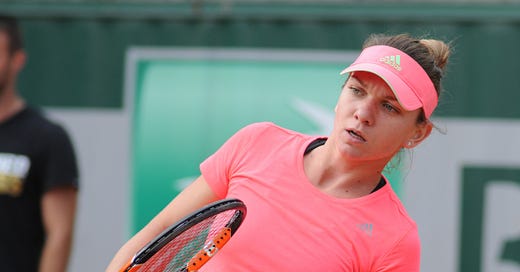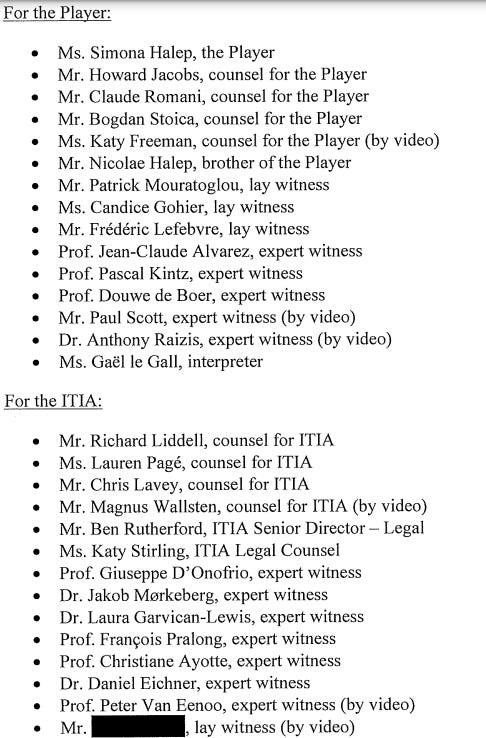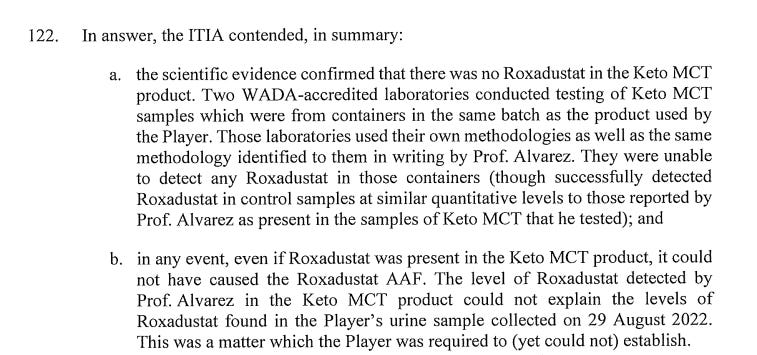How Simona Halep Won Big at CAS
A deep-dive into the 58-page decision that was finally published detailing how Simona Halep won her anti-doping appeal.
Yesterday as the tennis world was rightly swept up by waves of feelings and memories about 38-year-old Rafael Nadal’s expected-but-emotive retirement announcement, another big news item dropped, but it barely made a splash amid the roiling Rafa rapids.
Seven months and five days after the initial decision was announced on March 5th, the Court of Arbitration for Sport (CAS) finally published its full, 58-page decision explaining why it dramatically reversed the pair of four-year bans handed down against two-time major champion and former WTA No. 1 Simona Halep.
Halep’s initial penalty was the most severe anti-doping penalty ever handed down to a player of her caliber, but CAS reduced it to just nine months, which was backdated and thus reduced to time-served.
This was a major reversal in probably the most serious tennis anti-doping case ever, so let’s use this space to unpack the reasons CAS finally has laid out why all of this happened, hopefully without getting too bogged down in the technical science involved.
This post will look at the timeline of the case, the new arguments made by Halep against each of the charges, and what the entire episode says about the credibility of anti-doping procedures within tennis and at CAS. Please subscribe so you can read it all!

Why Did This Take So Long?
Delays have been a big part of the story throughout Halep’s case, so let’s lay out the timeline of this case before we get into the details of the decisions.
August 29, 2022:
After winning the Canadian Open weeks earlier in Toronto, Simona Halep suffers a shocking first round loss at the 2022 U.S. Open to qualifier Daria Snigur. Halep takes an anti-doping test after the match.
September 15, 2022:
Halep announces she is ending her 2022 season and undergoing nose surgery.
October 7, 2022:
The ITIA informs Halep that her U.S. Open sample has tested positive for roxadustat, an anemia drug which is a banned blood-doping agent in the same category as EPO (Erythropoietin), increasing hemoglobin and red blood cell production.
October 21, 2022:
The ITIA announces Simona Halep’s provisional ban, which makes the news of her positive test public.
December 2022 to February 2023:
Three experts in the Athlete Biological Passport (ABP) review patterns in Halep’s blood tests and determine that they appear “suspicious” and indicate “likely doping.” By February 2023, the panel of three experts have reached a “unanimous likely doping” determination based on Halep’s passport data.
March 2023:
The initial hearing date is postponed because of the looming additional charges from the experts’ assessment of Halep’s blood tests.
May 19, 2023:
ITIA announces a second, separate anti-doping charge against Halep, “relating to irregularities in her Athlete Biological Passport (ABP).” The initial charge still hadn’t been adjudicated, forestalled by these new developments.
Halep and her coach Patrick Mouratoglou, frustrated by the delays, call her prosecution “harassment” in posts on Instagram. She continues to rail against the delays in her case after subsequent further postponements to her hearing, and continues entering tournaments (including the 2023 U.S. Open) to show how ready she is to return to tour immediately.
June 28-29, 2023
Halep’s Independent Tribunal hearings on both the positive test and passport charges are held together in London.
August 21, 2023:
Halep removes herself from the U.S. Open draw at the deadline, just before the qualifying draw is made.
September 12, 2023:
The Independent Tribunal comes down hard against Halep in its verdict, handing her two four-year bans, one for each of the two charges she faced. The tribunal rejects her defense of Keto MCT supplement contamination since the high concentrations of roxadustat in her samples could not be explained by the low concentration of roxadustat in the supplement containers tested. The tribunal also declines to consider a blood sample which Halep had given in a non-anti-doping context in September 2022, as part of her preparation for nose surgery.
The pair of four-year bans would be served concurrently, keeping Halep out of the sport until October 2026.
From the ITIA’s summary of the news:
The tribunal accepted Halep’s argument that they had taken a contaminated supplement, but determined the volume the player ingested could not have resulted in the concentration of roxadustat found in the positive sample.
The ABP charge was also upheld, with the tribunal stating that they had no reason to doubt the unanimous “strong opinion” reached by each of the three independent Athlete Passport Management Unit (APMU) experts that “likely doping” was the explanation for the irregularities in Halep’s profile.
A full 126-page document detailing the decision is published later that month. (For a full breakdown of that initial decision, you can check out the thorough podcast I recorded with Tumaini Carayol for No Challenges Remaining.)
September 28, 2023:
As expected, Halep files an appeal against the decision at the Court of Arbitration for Sport (CAS), hoping for a more favorable verdict.
February 7-9, 2024:
After various procedural steps, the CAS appeal hearing is held in Lausanne.
March 5, 2024:
CAS announces that it has radically reduced Halep’s penalty, from two concurrent four-year bans to one backdated nine-month ban, which means Halep is immediately eligible to return to competition.
CAS does not fully explain why it reached such a dramatically different conclusion than the first tribunal, only briefly summarizing its decisions in a two-page document. CAS said they wanted to announce their verdict and reinstate Halep’s eligibility “as soon as practicable.” They added that “the reasoned award will be notified to the parties in due course. It will be published by CAS unless the parties request confidentiality.”
No one expected for “due course” publication to take more than seven months, however. The prolonged silence invited whispers as the months dragged on: maybe the document would never be seen, perhaps because one of the parties had requested it be suppressed?
Both sides denied this.
“I don’t have an explanation for the delay,” Halep’s attorney Howard Jacobs told me back in July.
A spokesperson at the International Tennis Integrity Agency (ITIA) similarly told me in July that “We are keen to see it and for it to be published.”
March 19, 2024 and beyond:
Just two weeks after her victory in arbitration, Halep returns to the tour after receiving a wildcard into the Miami Open. She loses in the first round to Paula Badosa, 1-6, 6-4, 6-3.
Despite her urgency to return and how quickly she resumed competing once she was eligible, Halep plays only sporadically after this, and does not become a relevant player in women’s tennis this season.
In July, Halep cited a knee injury for her struggles:
“It has been a very difficult period (almost two years) mentally and emotionally for me and struggling physically on top of that definitely doesn’t help…My instinct has always been to try to come back as soon as possible, but I am not a machine, I am a human being and I need time to recover from everything I have gone through.”
In the last seven months, Halep has played just two WTA 125 tournaments: In May, she retired midway through her second match at the WTA 125 in Paris; last week she won a match at the WTA 125 in Hong Kong before losing in the second round.
Halep, a former No. 1 who was ranked No. 7 when she tested positive, is currently ranked 878th in the world.
October 10, 2024:
CAS finally publishes a 58-page document detailing its ruling in Halep’s favor.
October 11, 2024:
This post breaking down the 58-page document is published!
Setting the Stage at CAS:
CAS appeals are heard de novo, meaning that it’s an entirely new proceeding that does not rely and is not beholden to the contents and decisions in the original hearing.
After the first 12 pages of the document are mostly devoted to recapping prior events, CAS says in its ruling: “As will be evident…it is apparent that there were some differences in the evidence adduced, and the submissions made.”
A panel of three arbitrators was assembled:
Both sides brought a deep bench of lawyers and witnesses to Lausanne for the hearings.1
Halep’s New Arguments on Her Positive Test:
The Math Is Faulty So It Doesn’t Need to Add Up
One of Halep’s stated reason for appeal was to “reject…that the source of contamination explains the concentration levels detected in the positive urine sample.”
The discrepancy between low concentration levels in the supplement and the relatively higher concentration in Halep’s sample had been a major factor in the ITIA’s ruling against Halep, especially since many of the experts ITIA consulted weren’t convinced that roxadustat was in the supplement at all. Halep’s side chose to argue that she shouldn’t have to prove why those numbers didn’t match.
The ITIA, as expected, rejects this contention:
[The article continues below for paid subscribers if you’d like to read more! There’s still more than half of it left, and if you’ve gotten this far I’ll bet you’d like to read the rest!]
Keep reading with a 7-day free trial
Subscribe to Bounces to keep reading this post and get 7 days of free access to the full post archives.








